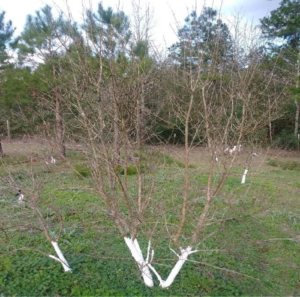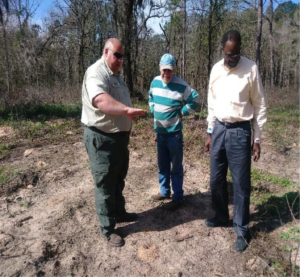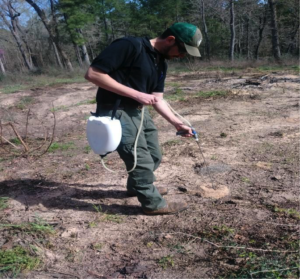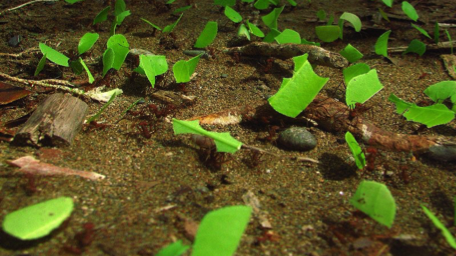June 4, 2018 – One of the challenges of farming is the presence of destructive elements, which have adverse effects on production and consequently revenue. Joseph Mezher, a Waller County farmer who specializes in fruit crops, medicinal plants, and vegetable production, faced problems with Leaf Cutter Ants. Mezher’s farm had a well-established peach orchard that was on the verge of destruction. For four years he tried to eradicate this pest, and because of the impact of these ants, growth, and production had reduced significantly. Mezher attempted several prescribed over-the-counter chemical remedies with no success.
 Even though Texas produces less fruit than what is consumed within the State, peach production is one of the leading deciduous fruits grown. The demand for high quality, locally produced peaches, has been continuously increasing and is bringing premium price therefore significantly increasing the revenues of our farmers who produce this crop. Production and yield vary, however, research has shown that a one-acre peach orchard can realize up to $3000.00 in profit per year when the fruit is wholesaled. Leaf Cutter Ants are problematic because they strip the trees of its leaves reducing the ability to photosynthesize. Thus, this peach orchard pest significantly decreases the production of the crop. A colony of Leaf Cutter Ants can remove the leaves from an entire tree in just one day. This species of ant is responsible for destroying more vegetation than any other group of insect. As a result, they cost the crop industry more than one billion dollars each year.
Even though Texas produces less fruit than what is consumed within the State, peach production is one of the leading deciduous fruits grown. The demand for high quality, locally produced peaches, has been continuously increasing and is bringing premium price therefore significantly increasing the revenues of our farmers who produce this crop. Production and yield vary, however, research has shown that a one-acre peach orchard can realize up to $3000.00 in profit per year when the fruit is wholesaled. Leaf Cutter Ants are problematic because they strip the trees of its leaves reducing the ability to photosynthesize. Thus, this peach orchard pest significantly decreases the production of the crop. A colony of Leaf Cutter Ants can remove the leaves from an entire tree in just one day. This species of ant is responsible for destroying more vegetation than any other group of insect. As a result, they cost the crop industry more than one billion dollars each year.

Prairie View Horticulturalist, Rafesh Brew, and Waller County Cooperative Extension Agent, Stedman Douglas, visited Mezher’s farm with the aim of finding the best possible solution to his profit-buster of a problem. Based on their assessment, two colonies — one colony may have up to 10 million ants — and some mounds were found to be present near a few trees with 95% of the foliage removed. Interestingly, Leaf Cutter Ants do not eat the leaves. Instead, they use them to make a fungal garden, which is their primary source of food. However, for practical control, the queen in the colony has to be targeted which may be located up to 25 feet underground covering an area up to one acre. Application of active ingredients in Fipronil was identified as an effective and suitable solution to get the job done.  Applied as directed, the mode of action is characterized by disrupting the insects’ central nervous system, which causes hyperexcitation. This slow reacting insecticide allows the ants to return to the colony and pass the poison to others through physical contact and feces. Texas A&M AgriLife partners were invited to develop experiential training to treat the colonies while other local farmers and Texas A&M AgriLife Wildlife trainees attended to learn and adopt the new technique in their own best practices. A total of ten attendees were present at an on-site workshop to address the persistent damage Mezher had suffered for more than four years. Another farmer in attendance had a similar problem and applied the treatment to his orchard. Overall, the result made a significant difference in production and economic impact for the Waller County area.
Applied as directed, the mode of action is characterized by disrupting the insects’ central nervous system, which causes hyperexcitation. This slow reacting insecticide allows the ants to return to the colony and pass the poison to others through physical contact and feces. Texas A&M AgriLife partners were invited to develop experiential training to treat the colonies while other local farmers and Texas A&M AgriLife Wildlife trainees attended to learn and adopt the new technique in their own best practices. A total of ten attendees were present at an on-site workshop to address the persistent damage Mezher had suffered for more than four years. Another farmer in attendance had a similar problem and applied the treatment to his orchard. Overall, the result made a significant difference in production and economic impact for the Waller County area.
This work was supported by the USDA National Institute of Food and Agriculture, 1890 Extension Formula Program projects under Section 1444.

Stedman Douglas
Agriculture and Natural Resources Waller County Extension Agent
shdouglas@pvamu.edu
(979) 826-7651

